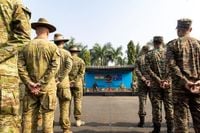In the wake of escalating tensions in the Indo-Pacific region, Australia is reassessing its defense strategies, particularly in the northern territories, where the presence of military bases is deemed crucial for national security. The recent Defence Strategic Review (DSR) has underscored the need for urgent upgrades to these bases, particularly in light of China's military expansion and the emerging interests of Russia in Southeast Asia.
Western Australia’s northern regions, often described as the "engine room of the nation's economy," are strategically significant for the Australian Defence Force (ADF). According to Troy Lee-Brown, a research fellow at the University of Western Australia's Defence and Security Institute, bases such as Curtin and Learmonth serve as Australia’s first line of defense. He emphasized, "The bases to the north are important because it's our first line of defence." This statement reflects a growing consensus among defense experts regarding the need for a robust military presence in the face of shifting geopolitical dynamics.
The DSR, released in 2023, called for these northern bases to be "urgently and comprehensively remediated." A spokesperson for the Defence Department revealed that the latest Integrated Investment Program allocates between $14 and $18 billion over the next decade to enhance bases, ports, and barracks across northern Australia. Significant funding has already been directed towards infrastructure upgrades, including over $1 billion approved for projects in northern Western Australia. This includes more than $700 million earmarked for airfield upgrades at RAAF Base Learmonth, which will widen and strengthen the runway and taxiway. Construction is set to commence shortly, with completion expected by 2027.
While the government’s commitment to upgrading northern bases is evident, questions remain about the pace and sufficiency of these efforts. Kim Beazley, former Labor defense minister and ambassador to the U.S., expressed concerns about the need for increased resources. He stated, "We are going to have to, over the next few years, shift priorities to get there. It does cost money and it does take people, and all has to be provided in order to be able to do it." Beazley acknowledged that while the plans are in place, the crucial step now is to secure the necessary funding.
The political landscape surrounding defense funding is also evolving. On April 23, 2025, the Coalition announced a pledge to increase defense spending from the current 2.04 percent of Australia’s GDP to 2.5 percent by 2030. This ambitious plan, described as a record announcement of $21 billion for defense, aims to bolster the country’s military capabilities, particularly in the north. In contrast, the Labor Party has proposed a more modest increase to 2.3 percent of GDP by 2033. Prime Minister Anthony Albanese highlighted that the Labor government has already committed an additional $57 billion in funding over the next decade.
Despite these pledges, there are pressing concerns regarding specific capabilities. Peter Dean, director of foreign policy and defense at the University of Sydney's U.S. Studies Centre, pointed out a "glaring hole" in Australia’s integrated air and missile defense. He emphasized the urgent need for ground-based air defense systems to protect critical military bases in northern Australia. Dean estimated that a medium-range surface-to-air missile project would cost between $6 and $8 billion. However, he noted the lack of dedicated funding for such initiatives, which is essential for enhancing national security.
Another significant issue is the staffing of the northern bases. Currently, both Learmonth and Curtin are classified as "bare bases," meaning they are minimally staffed but can accommodate an influx of troops quickly. Dr. Lee-Brown remarked, "As the region becomes more fractious and strategic warning time has evaporated, it's strategically important for Australia to have its northern bases running at a greater capacity than they currently are." However, neither major political party has committed to permanently staffing these bases, leaving a gap in readiness.
Defence Minister Richard Marles acknowledged the importance of northern bases but refrained from detailing Labor’s commitments. He stated, "We need a defence force that can project, because the location of Australia's national security is not the coastline of our continent; in fact, it lies much further out." Marles stressed that upgrading these bases is a critical component of restructuring the defense force.
Meanwhile, Western Australia Premier Roger Cook expressed satisfaction with the current levels of military presence in the region, stating that significant work has been done to relocate defense assets into Western Australia. Cook noted, "We believe that there's a lot of strategic economic assets there. We believe that it is a point of vulnerability because it's such a vast coastline." He commended the efforts made by the Albanese government to enhance the military footprint in the north.
As Australia grapples with these defense challenges, it is also deepening its defense cooperation with India, particularly in maritime security. Over the past 15 years, the relationship between Canberra and New Delhi has advanced significantly, facilitated by strong leadership from both nations. However, experts warn that an imbalance in defense cooperation—where naval ties have flourished while air force and army connections lag—could limit the full potential of this partnership.
To address this, analysts suggest several steps for enhancing cooperation. Establishing regular bilateral air force exercises, augmenting India’s defense representation in Canberra with air force and army officers, and broadening the scope of existing military exercises to include joint operations across all services are among the recommendations. These initiatives aim to foster a cohesive approach to defense that leverages the strengths of both countries’ militaries.
As the geopolitical landscape continues to evolve, Australia’s defense strategies will require agility and foresight. The need for comprehensive upgrades to northern bases and enhanced international cooperation is more pressing than ever, ensuring that Australia remains prepared to face the challenges of a changing world.




